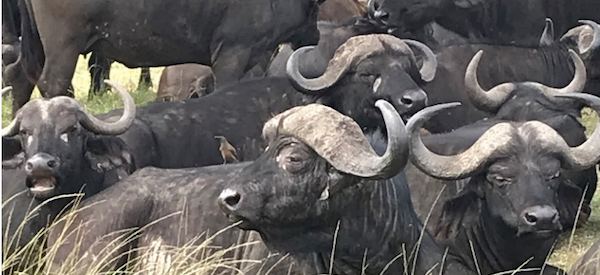African Buffalo, Oxpeckers, and Leadership

Last month, I wrote about my experience in Kenya and particularly how a pride of lions reminded me of effective teams and strong leadership. Today’s blog is about something my niece and I learned from the guides in Serengeti and the mutual beneficial relationships between different species of animals.
After being in Kenya for about a week, we flew to Tanzania to spend three days in the Serengeti National Park. This park had a different feel for us than the Maasai Mara in Kenya; the Serengeti was much dryer with less vegetation and had a more open feel (not as many places for the predators or the prey to hide). Heading out for a game drive one morning, our guides stopped the jeep to give us time to observe a herd of African buffalo. At this point in our trip, we had seen hundreds of buffalo, and so we really weren’t paying too close attention. But then Sirili, one of our guides, pointed to one of the buffalo and said, “See, that’s a symbiotic relationship.” He was pointing to a small bird, an oxpecker, sitting on top of the buffalo. His explanation of a symbiotic relationship is when two different species benefit from having a relationship together. In the case of the oxpecker and the African buffalo, these small birds feed on the tiny parasites that live on the buffalo – the birds benefit from an endless food source, and the buffalo benefit from a free cleaning.
We saw another example of symbiosis between the baboons and the impala. These two species have a special relationship: the baboons provide a security detail for the impala (unfortunately for predators, the baboons are the big mouths of the bush), and the impala dig up bugs for the baboons to snack on. It’s not always a “pretty” relationship, but it’s always an effective and efficient one.
We often use assessments like DiSC or MBTI to help leaders develop a deeper understanding of their own workplace preferences, and also to understand how to be more effective with others who have a different workplace preference from their own – how to create a symbiotic relationship with people who are different from us. The most valuable part of these assessment tools is how we use the information. Are we really leveraging and using the strengths of everyone on the team? We say we want different approaches and perspectives, so how do we really use that information to support a thriving culture and organization? Work with your teams on how you can leverage more of the strengths of the team – and how you can leverage more of the differences – to create a symbiosis that will help you perform at higher levels than ever thought. And if you are interested in talking about different assessments that work for teams, please reach out to me cindy@getemergent.com.
Keep working together, and keep leading!
PS – this is a picture I took in Kenya – the buffalo are very photogenic.

Spot on article! Thank you for sharing